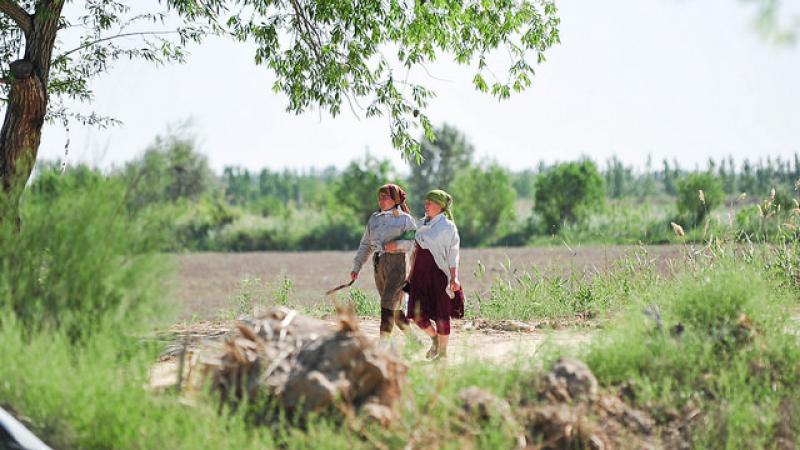Markets offer women opportunities to capitalize on ecosystem services

Present laws in Kazakhstan widely recognize the principle of gender equality, but, as in many other countries, the reality is different. Women are considered inferior to men in the Kazakhstani society, and as a consequence many are cut-off from opportunities to generate income and make decisions.
But one factor can make a difference in a woman’s ability to capitalize on the resources available to her: Access to markets.
Gender gap grows in Kazakhstan
During the Soviet era, tradition, religion and social status had less influence on gender roles than is the case today. Then, most public services were either free or compulsory, and they had to fulfill certain quotas. Different organizations catered to the needs of specific parts of society, such as the youth or patriots, and played a great role in providing opportunities for both men and women.
In this way, the governance system – though not entirely immune to stereotypical thinking about the predefined roles of men and women in family and society – did offer opportunities for greater gender equality.
However, after Kazakhstan’s independence in 1991, the country went through a period with growing nationalism, which was accompanied by a return of traditional and religious values, including growing inequality between men and women. Studies show that gender inequality increased after independence in terms of patriarchal attitudes, domestic violence and women’s loss of decision-making power in the public sphere (ADB 2006).
Today, gender inequality is evidenced in gender wage gaps and in an increasing reluctance to hire women, especially those of childbearing age or with young children. While the new era also fostered self-confidence among women, especially in the cities, many rural women are locked into traditional gender roles without opportunities to make their own incomes or decisions.

Women in the field in Central Asia. Photo Credit: Neil Palmer/IWMI.
Market access matters
A WLE project led by the International Center for Agriculture in Dry Areas (ICARDA) recently undertook a case study in southern Kazakhstan to explore the factors that influence women’s opportunities. The study revealed that women’s contribution to household income, as well as their demand for and use of ecosystem services, is not only influenced by culture and religion, but even more so by access to basic infrastructure, including markets.
The case study considered Bugun, Staryi Ikan and Karachik villages, which sit like pearls on a string along the Arys-Turkestan canal (supplied with water from Bugun reservoir). The canal delivers water appropriate for irrigation, that is, an ecosystem service, and the three villages represent upper, middle and tail-end users of water.
Preliminary findings of the study show that while the women in the three villages have a lot in common – including doing the unpaid, laborious domestic work, assisting their husbands in farming and taking on low-paying jobs – their engagement in income-generating activities and their use of water differ depending on their proximity to the nearest market.

Map of the study site, highlighting the three villages (Bugun, Staryi Ikan and Karachik), the reservoir and the nearest market.
Income generation empowers women
For example, families in Bugun have the easiest access to canal water and the highest average land holding (three to five hectares) compared to the other two villages. However, due to the lack of access to markets, women in this village do not capitalize on these services, that is, land and water, to generate income. Instead, they grow vegetables only for home consumption.
Staryi Ikan, located in the middle of the canal, has less easy access to canal water compared to Bugun, but it is located slightly closer to the market.
Families in Staryi Ikan own much less land than those in Bugun, only between one and four hectares. Despite the limited access to land and water, women in this village grow vegetables by tapping into groundwater to make up for the limited supply from the canal. However, everything they produce is consumed by their families – mainly due to their lack of access to the market.
Finally, families in Karachik – the village located at the tail-end of the canal – have the least easy access to water. In addition, they mostly rent the land that they cultivate, and family plots average one and a half to four hectares, similar to those in Staryi Ikan. As in Staryi Ikan, the families in Karachik also rely heavily on groundwater for irrigation, which comes with added expenses for pumping.
Yet, the study found that the women in Karachik are the most economically vibrant as compared to those in the middle and upstream villages. Because this village is closer to the local market than the other two, the women here have the opportunity to actively contribute to their household’s income. Their contribution validates them as equal participants in budget discussions and other decision-making processes.
Women’s opportunities to capitalize on available ecosystem services can be influenced by various factors, including cultural and religious norms. However, in this particular case, access to markets proved to be the most prominent factor granting women active economic participation and, by extension, greater equality with men.
This research is conducted in the framework of the CGIAR Research Program on Water, Land, and Ecosystems.
Reference
Asian Development Bank (ADB). 2006. Country Gender Assessment: Republic of Kazakhstan. Manila
